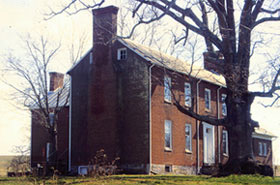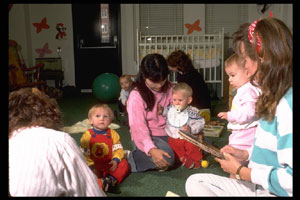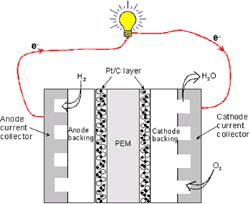UNIVERSITY LIBRARIES TO COLLABORATE ON KENTLAND FARM HISTORY PROJECTS Work to uncover the history of Montgomery County's Kentland Farm and its slave cemetery has received an added boost, thanks to two new grants that will support research on the plantation, the cemetery, and the significance of the plantation to individuals in the surrounding communities.
One grant funds the Kentland Slave Cemetery Marker Project, a collaborative effort between the residents of Wake Forest, an African American community adjacent to Kentland; the Kentland Historic Revitalization Project; the Roanoke Regional Preservation Office of the Department of Historic Resources; and University Libraries. The project will determine the location of the cemetery and verify its use as a burial ground. Funds were received to commemorate the cemetery with a permanent stone marker honoring the people buried there. A public dedication ceremony will honor the dead. The residents of Wake Forest are descended, for the most part, from slaves of the former Kentland plantation. As many as 300 of those slaves may be buried on the grounds. The unmarked burial site, identified by several Wake Forest community members, lies in a field where fescue grass is now grown. The location will be confirmed through an archaeological survey conducted this fall by Tom Klatka, archaeologist for the Virginia Department of Historic Resources and a member of the Kentland Historic Revitalization Project steering committee. "The cemetery marker project will strengthen the relationship between the black and white communities and between the academic and local communities, including Virginia Tech, Radford University, Wake Forest, and McCoy," Kennelly said. "This project also will educate the public about the past in the hope of contributing to a more equitable future." The second grant will fund the Brush Mountain Oral History Project: Place and Memory in the New River Valley and will involve collecting oral history narratives from residents of the Appalachian communities of Wake Forest, McCoy, and Long Shop. The goal of the interviews is to learn how memory and place inform the subjects' sense of identity. This project also will try to discover any roles the former plantation may have played in the lives of the interviewees. The project marks one phase of a collaborative venture between community members and Virginia Tech faculty to revitalize Kentland's historic district. Most of the interviewees are community elders who are eager to add their stories of the community and of Kentland to the public record. Interviews will be made available through Tech's Special Collections Department website at http://spec.lib.vt.edu/ and through the Virginia Heritage database at http://www.lib.virginia.edu/speccol/vhp/about.html. Development will begin on a special Internet site showcasing the interviews, primary source materials, and other documentation about the history of this rural, agricultural area along the New River near Brush Mountain. "We hope to compile a book for the community, which we would ultimately like to publish locally," Cook said. "On a larger scale, we will use the oral history project as a springboard to hold a number of "community days" at Kentland, which we hope will lead up to an open house/fund raiser. The purpose of the community days is to make people in surrounding communities a part of the revitalization project and to let them determine how they would like to be represented and how they would like to see their histories represented." The two projects are part of a larger initiative through which the Kentland Historic Revitalization Project aims to preserve the site while revitalizing the Kentland historic district as a community-based, multicultural museum/living history site. FULL-TIME CHILD DEVELOPMENT CENTER FOR LEARNING AND RESEARCH TO OPEN
"The need for quality day care at Virginia Tech has been one of the most important issues identified through a campus-wide survey, focus groups, and interviews as part of the university's Advance project to promote women in science and engineering," said Pat Hyer, associate provost. "I have reports in my office dating back more than 20 years about the need for day care on campus, and I am just delighted that we are going to be able to take this important first step to address such a critical need. It will make a big difference in our efforts to recruit and retain young faculty--both women and men. "The new Center will help us to continue to provide high quality, field-based educational opportunities for our students and sponsored research in early education and child development," said Jerry Niles, dean of the College of Liberal Arts and Human Sciences. "It will also be a key component of an interdisciplinary developmental science initiative between the departments of human development and psychology." The CDCLR will operate three classrooms, one for 10 toddlers (15 to 36 months), another for 15 young preschoolers (3-4 years), and 15 older preschoolers (4-5 years). The center will be open from 7:30 a.m. to 5:30 p.m. and will operate year-round, except for a one-week summer break, one week for winter/holiday break, Memorial Day, Independence Day, two days for Thanksgiving break, and professional development. The cost per child will be $700 per month for a one-year contract. "We will offer a developmentally appropriate environment in which children are given opportunities to make choices, pursue their own questions and concerns, connect what is known and unknown, and be successful as they explore and discover through play, informal learning activities, and projects," said Victoria Fu, director of the center and a professor in the department of human development. "We also believe the parent-child relationship is the most important context for learning and development, so we strive to maintain close connections between home and school, and value the cultural and individual perspectives that families bring to the program," Fu said. The Center will support three full-time appointments, including Curriculum Director Kate Mosher Milne, and Assistant Director Christine McCartney. A research scientist, Isabel Bradburn, also will join the Center this fall. The Center's priority is to serve families of Virginia Tech faculty and staff. With few exceptions, enrollments are on a first-come, first-served basis. Parents can put their child's name on a waiting list by filling out an application form during pregnancy or any time thereafter. For more information, please visit http://www.humandevelopment.vt.edu/cdclr.html or contact Christine McCartney (cmccartn@vt.edu), (540) 231-6148. WOOD CENTER PROVIDES GAVELS FOR VIRGINIA LEGISLATURE
The Thomas M. Brooks Forest Products Center is a 35,000 square foot complex on the edge of the Virginia Tech campus in the Corporate Research Center. The Brooks Center, which houses faculty, staff, and students in the department of wood science and forest products, contains research laboratories and equipment. The center contains labs for wood base composites manufacture and testing, a high-bay wood engineering lab with full-scale timber testing equipment, the William A Sardo Pallet Laboratory, and the Center for Unit Load laboratory. A new wood drying laboratory was recently completed with a state-of-the-art laboratory kiln. UNIVERSITY-INDUSTRY ALLIANCE TO ADVANCE FUEL CELL DISCOVERIES
"This time, the National Science Foundation wants to see the new science and technology more widely applied," McGrath said. "Our proposal outlined a plan for that next step. Virginia Tech will work with Battelle, Los Alamos National Laboratory, Virginia's Center for Innovative Technology, several companies, and Virginia Commonwealth University to bridge gaps in materials, processes, and test methodologies." Battelle, which manages several Department of Energy national laboratories, including Los Alamos National Laboratory, Pacific Northwest, and Oak Ridge, has an exclusive option from Virginia Tech Intellectual Properties Inc. to identify potential national and international markets for new fuel cell membrane technologies. Faculty members and students in Virginia Tech's Materials Research Institute have developed and patented new inexpensive, efficient co-polymeric materials for use in fuel cells and processes for creating the materials. Fuel cells have the potential to supply clean energy for cars, homes, and portable electronics. Limiting features are the characteristics of polymeric materials used in the proton exchange membrane (PEM) film. The PEM allows hydrogen protons (H+ ions) to pass through to the oxygen side of the fuel cell, where it can release electrochemical energy by reaction with the oxygen. The McGrath group has developed polymeric films that are viable in high heat environments, conductive, and strong enough to be used as advanced materials in fuel cells. They have created a process that incorporates the ion conductor at the monomer level (initial stage of synthesis) rather than after the polymer has been formed, making the materials more durable and easier to create in a scaled-up manufacturing setting. Battelle has extended its option on the patents until March 2005. The PFI plan also calls for sharing information on the transition from the laboratory to full-scale production of the fuel cell materials. There have already been discussions with the GM fuel cell materials group in Rochester, N.Y., Motorola in Tempe, Ariz., United Technologies Fuel Cells of Hartford, Conn., and Teledyne Energy Systems of Los Angeles, which have shared testing protocols for automotive, portable, and stationary power applications. "Our plan is, with Battelle's guidance, to interact with small and large companies which are interested in our film forming materials, and then follow up on their suggestions and requests," McGrath said. The Center for Innovative Technology will promote workforce development in Virginia by increasing the Virginia technology community's awareness of the fuel cell PFI and by identifying opportunities for partnering with existing and start-up corporations within the state. Hydrosize Technologies Inc. of Raleigh, N.C., has already scaled up production of several of the PEM materials to kilogram quantities, and the Polymer Technology Group Inc. group in Berkeley, Calif., has successfully developed continuous film casting capabilities. Nanosonic Inc. of Blacksburg is investigating some portable power applications of the new PEM material. In his role as co-principal investigator on the grant, McNamee will provide leadership in organizing an annual open forum highlighting progress in the National Science Foundation fuel cell PFI effort as part of the Virginia universities' role in economic development. It is planned that the audience will include members of the Virginia General Assembly, Virginia members of Congress, large and start-up corporations in the commonwealth, and the investment community. Other Virginia Tech researchers who will be active in the PFI are Michael von Spakovsky, of Blacksburg, professor of mechanical engineering in the College of Engineering at Virginia Tech and director of the Center for Energy Systems Research, and Judy Riffle, of Blacksburg, professor of chemistry in the College of Science at Virginia Tech and director of the Macromolecular Science and Engineering graduate degree program. The researchers expect they will have a National Science Foundation research experience for undergraduates (REU) program as part of the PFI by next summer. "We were able to have an REU as part of the previous PFI," McGrath said. For more information, contact James McGrath at (540) 231-5976 or jmcgrath@vt.edu. Learn more about McGrath at www.chemistry.vt.edu/chem-dept/office/McGrath/jmcgrath.htm. |



